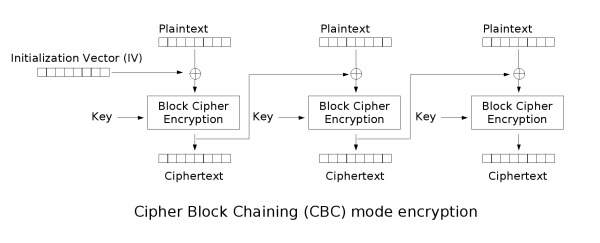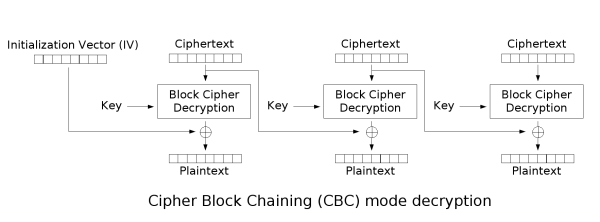CBC¶
Warning
The current page still doesn't have a translation for this language.
You can read it through Google Translate.
Besides, you can also help to translate it: Contributing.
CBC全称为密码分组链接(Cipher-block chaining) 模式,这里
- IV 不要求保密
- IV 必须是不可预测的,而且要保证完整性。
加密¶

解密¶

优缺点¶
优点¶
- 密文块不仅和当前密文块相关,而且和前一个密文块或 IV 相关,隐藏了明文的统计特性。
- 具有有限的两步错误传播特性,即密文块中的一位变化只会影响当前密文块和下一密文块。
- 具有自同步特性,即第 k 块起密文正确,则第 k+1 块就能正常解密。
缺点¶
- 加密不能并行,解密可以并行。
应用¶
CBC 应用十分广泛
- 常见的数据加密和 TLS 加密。
- 完整性认证和身份认证。
攻击¶
字节反转攻击¶
原理¶
字节反转的原理十分简单,我们观察解密过程可以发现如下特性:
- IV 向量影响第一个明文分组
- 第 n 个密文分组可以影响第 n + 1 个明文分组
假设第n个密文分组为C_n,解密后的第n个明文分组为为P_n。
然后P_{n+1}=C_n~\text{xor}~f(C_{n+1})。
其中f函数为图中的\text{Block Cipher Decryption}。
对于某个信息已知的原文和密文,然后我们可以修改第n个密文块C_n为C_n~\text{xor}~P_{n+1}~\text{xor}~A。然后再对这条密文进行解密,那么解密后的第n个明文快将会变成A。
例题¶
from flag import FLAG
from Crypto.Cipher import AES
from Crypto import Random
import base64
BLOCK_SIZE=16
IV = Random.new().read(BLOCK_SIZE)
passphrase = Random.new().read(BLOCK_SIZE)
pad = lambda s: s + (BLOCK_SIZE - len(s) % BLOCK_SIZE) * chr(BLOCK_SIZE - len(s) % BLOCK_SIZE)
unpad = lambda s: s[:-ord(s[len(s) - 1:])]
prefix = "flag="+FLAG+"&userdata="
suffix = "&user=guest"
def menu():
print "1. encrypt"
print "2. decrypt"
return raw_input("> ")
def encrypt():
data = raw_input("your data: ")
plain = prefix+data+suffix
aes = AES.new(passphrase, AES.MODE_CBC, IV)
print base64.b64encode(aes.encrypt(pad(plain)))
def decrypt():
data = raw_input("input data: ")
aes = AES.new(passphrase, AES.MODE_CBC, IV)
plain = unpad(aes.decrypt(base64.b64decode(data)))
print 'DEBUG ====> ' + plain
if plain[-5:]=="admin":
print plain
else:
print "you are not admin"
def main():
for _ in range(10):
cmd = menu()
if cmd=="1":
encrypt()
elif cmd=="2":
decrypt()
else:
exit()
if __name__=="__main__":
main()
可见题目希望我们提供一个加密的字符串,如果这个字符串解密后最后的内容为admin。程序将会输出明文。所以题目流程为先随便提供一个明文,然后将密文进行修改,使得解密后的字符串最后的内容为admin,我们可以枚举flag的长度来确定我们需要在什么位置进行修改。
以下是exp.py
from pwn import *
import base64
pad = 16
data = 'a' * pad
for x in range(10, 100):
r = remote('xxx.xxx.xxx.xxx', 10004)
#r = process('./chall.sh')
r.sendlineafter('> ', '1')
r.sendlineafter('your data: ', data)
cipher = list(base64.b64decode(r.recv()))
#print 'cipher ===>', ''.join(cipher)
BLOCK_SIZE = 16
prefix = "flag=" + 'a' * x + "&userdata="
suffix = "&user=guest"
plain = prefix + data + suffix
idx = (22 + x + pad) % BLOCK_SIZE + ((22 + x + pad) / BLOCK_SIZE - 1) * BLOCK_SIZE
cipher[idx + 0] = chr(ord(cipher[idx + 0]) ^ ord('g') ^ ord('a'))
cipher[idx + 1] = chr(ord(cipher[idx + 1]) ^ ord('u') ^ ord('d'))
cipher[idx + 2] = chr(ord(cipher[idx + 2]) ^ ord('e') ^ ord('m'))
cipher[idx + 3] = chr(ord(cipher[idx + 3]) ^ ord('s') ^ ord('i'))
cipher[idx + 4] = chr(ord(cipher[idx + 4]) ^ ord('t') ^ ord('n'))
r.sendlineafter('> ', '2')
r.sendlineafter('input data: ', base64.b64encode(''.join(cipher)))
msg = r.recvline()
if 'you are not admin' not in msg:
print msg
break
r.close()
Padding Oracle Attack¶
具体参见下面的介绍。